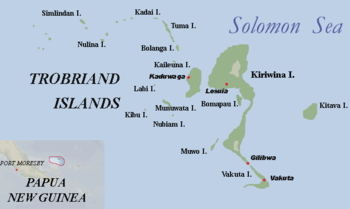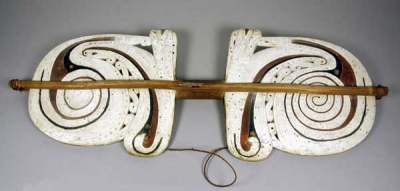Dance shield (1900.55.453)
 Trobriand IslandsDance shield from the Trobriand Islands, Oceania. Thought to have been collected by Norman Hardy. Given to the Museum by Robert Willkins in 1900.
Trobriand IslandsDance shield from the Trobriand Islands, Oceania. Thought to have been collected by Norman Hardy. Given to the Museum by Robert Willkins in 1900.
This unusual shield is a dance shield known as a kaydiba. It comes from the Trobriand Islands (today officially known as the Kiriwina Islands), an archipelago of coral atolls situated in Milne Bay Province off the eastern coast of Papua New Guinea. The region is part of the Massim cultural area where art favours two-dimensional carving covered with low relief abstract designs and the application of white lime. This shield clearly follows this aesthetic, its two paddles carved with curvilinear designs and painted in red, black on a white background.
The Beautiful Warrior
The kaydiba was a shield used entirely for dancing in the energetic male dances of the same name. There is a three-month dancing season in Trobriands culture, termed the milamila, during which the kaydiba was a central attraction. In this dance, young men wore loincloths and elaborate cockatoo feather headdresses, and held these dance shields in their right hands. They danced in an anti-clockwise circular formation, around the singers and drummers. The kaydiba was a major social opportunity for the single men to display their beauty to the watching women, who, in turn, took the chance to spot, evaluate and approach a potential husband.
The shield is symmetrical across a central handle. The main spirals with the dark red hooks represent - in a highly schematic form - the beak of a hornbill bird. The bulges at the base of each paddle near the handle resemble the head of a snake with open jaws, which symbolises the penis in Trobriands mythology. The carving of the elaborate, curvilinear fretwork required very high levels of skill, and certain individuals gained a reputation as a specialist in carving dance shields, canoe prow-boards, or other fine works. To possess an artefact made by such a man was a mark of distinction, and their work was much sought after. Some scholars have argued that these curvilinear designs like these are intended to magically bewilder and mesmerise the viewer, in order to make social relations between trade partners flow as fluidly as the designs. If so, it seems quite reasonable that a young man might also use the power of such carvings to aid him in the course of love.





